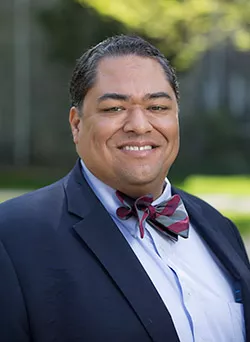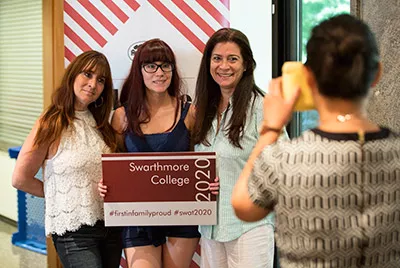Maximizing Opportunity

It was the spring of 2015, early in Varo Duffins’ tenure at the College, when a mother and daughter who had just finished a campus tour made a ball-of-nerves beeline for the Financial Aid Office.
“They didn’t think they could ever afford to come to this institution — that they could ever make it happen,” says Duffins, director of financial aid. “But you could see in their eyes they had fallen in love with Swarthmore.”

“The size of our staff and the number of students we have to serve allows us to get to know families in a unique way, even among other small private colleges, says Director of Financial Aid Varo Duffins.
At most schools, that would have been the end of the story, their dream dashed. But Swarthmore isn’t like most schools. It offers students an array of financial support from all corners of the College. Whether it’s meeting 100 percent of demonstrated tuition needs of qualified students or funding academic travel and research projects from New York to New Zealand, the College strives to make a world-class education accessible to all.
“The most rewarding aspect for me is the education that these students get,” says Kristin Moore, director of services in the Financial Aid Office. “I get to drop a stone in a pond and see the ripple of students doing all of these amazing things all across the globe.”
These resources would not be available without the generous support of alumni (more than 8,500 of whom gave last year), foundations, parents, and friends of the College. The bulk of that support goes to The Swarthmore Fund, which helps to bridge the gap between support from the College’s carefully managed endowment and what it costs to provide transformational educational experiences for all students.
The primary source of financial support is the scholarship funding that Swarthmore provides to more than half of all students. This year, aided students receive an average award of $47,034. Reflecting the College’s commitment to access and diversity, a third of the students who receive aid this year have a family income of $60,000 or less, and 20 percent of current first-year students are the first generation in their families to attend college.
“I can’t tell you how rewarding it is to walk into any school in America and know that, regardless of a student’s background or family income, an education at Swarthmore may be financially possible," says Associate Dean of Admissions and Director of Access and Programming Andrew Moe. "Most admissions officers don’t have that luxury.”
The main responsibility of the Financial Aid Office is to make sure that students get all the need-based aid for which they are eligible, says Duffins. Just as important for the staff is informing and counseling students and their families on the financial aid process, and helping them navigate its complexities from their initial contact with the College right through graduation.
“It’s not just number crunching but making the process as transparent and painless as possible for families,” says Moore. “It’s a fine line to walk.”
The College also takes numerous steps to make sure that all students have the tools to maximize their education. Between the Provost’s Office, the Richard Rubin Scholar Mentoring Program, Lang Center for Civic & Social Responsibility, and academic departments, nearly $800,000 is offered each year for internships, summer research and projects for social impact, and creative arts endeavors around the world. This summer, for instance, Swarthmore offered grants to more than 200 students, which is more than twice the total from 2013.

Reflecting the College’s commitment to access and diversity, a third of the students who receive aid this year have a family income of $60,000 or less, and 20 percent of current first-year students are the first generation in their families to attend college.
Four students working in Associate Professor of Chemistry Liliya Yatsunyk’s research lab had the unique opportunity this summer to meet, collaborate, and present their research to world-leading experts in their research field.
"They presented and defended their work, they participated in the discussions, and ran experiments alongside highly qualified scientists,” says Yatsunyk, who traveled with the students to visit the lab of Brad Chaires at the James Graham Brown Cancer Center Louisville, Ky. “The most important message however, was of scientific collaboration and of an excitement for scientific discovery. Throughout our visit, I could not stop feeling proud about my students, their humanity, motivation, and scientific accomplishments.”
The Provost’s Office also provides financial support for conference travel to students, across all disciplines. This past year, destinations included the Conservation Biology Conference in New York City and the CSPDWeek conference for computer science educators in Denver, Colo. The Dean’s Office and the Center for Innovation and Leadership also sponsored a student trip to Silicon Valley for a week of experiential learning, for which all students were eligible.
Swarthmore’s support can begin before students even enroll, including application-fee waivers and free travel for students from low-income backgrounds to Admissions Office events such as Swatlight and Discover Swarthmore. The College also offers $1,500 interest-free loans to international students who receive aid, for books and supplies when arrive on campus, and free trips home to see far-flung family in their second year. Financial support extends beyond a student’s time on campus, as well. The $4,000 postgraduate fellowship, for which recent initiates are eligible, is offered by the Swarthmore chapter of the Phi Beta Kappa Society.
One of the Lang Center’s signature programs is the Lang Opportunity Scholarship Program. Any sophomore may apply for the program, whose benefits include a $10,000 grant, a designated advisor, and networking opportunities to support the development of a project that creates a needed social resource in the U.S. or abroad. The Lang Center also offers multi-year support to groups of students through Project Pericles Fund of Swarthmore; provides funding for summer internships and pilot projects through the Swarthmore Foundation; in partnership with Peace and Conflict Studies, connects students to opportunities like Davis Projects for Peace funding; and hires and trains students to work as Lang Center Associates or community leaders at local nonprofits through programs like Dare 2 Soar. These opportunities closely connect to the classroom, since the Lang Center asks students who apply for scholarships, project grants, and internships to outline the ways in which their proposals would add dimension to their course work.
Other opportunities are directly embedded in the curriculum. Last spring, students in Professor of Chinese Haili Kong's Tea in China: Cultural and Environmental Perspectives course traveled to China and Taiwan to gain firsthand experience in tea farming and tea making.

Guided by alumni hosts, 11 students went behind the walls of Silicon Valley giants like Apple, Google, and Salesforce, exploring how the liberal arts prepare them for a life in tech on a Center of Innovation and Leadership trip.
Between these and many other opportunities at Swarthmore, the main challenge facing all the offices and centers that offer financial support is making students aware of all that is available. So, three years ago, Career Services initiated an annual Summer Opportunities Fair in the late fall to get the word out, including to first-generation students and students from a low-income background who may benefit most.
"The fair is a way for students to see the breadth of resources available to them, some of which they may never have considered before," says Pattie Kim-Keefer, who organizes the event. "For staff and faculty, it gives them a way to connect with students and share resources that can help them figure out their summer plans."
Echoing that message is the Financial Aid Office staff, who aim to offer “high-touch service” to students and their families.
“We’re more hands-on than a lot of schools,” says Moore. “We take the extra time to work with families, holding a lot of conversations across all boundaries. That’s the aspect of our office that we take most pride in.”
“It’s a very tactile-type place,” adds Duffins. “The size of our staff and the number of students we have to serve allows us to get to know families in a unique way, even among other small private colleges.”
Among them, the mother and daughter from that tour, whose mix of nervousness and excitement the financial aid staff so vividly recalls. That mother came back to Swarthmore in August — this time to move her daughter in.
“She walked in here looking six inches taller,” says Duffins, “and must have hugged everyone in the office. To see the look on her face and to know what this opportunity means to their family, that’s special. And there’s quite a lot of that here at Swarthmore.”
Editor's note: This is the second in a series of stories on Swarthmore's comprehensive approach to supporting students. The first installment focused on how staff, faculty, and students from all areas of the College help new students to feel at home and aware of resources available to help them succeed.



